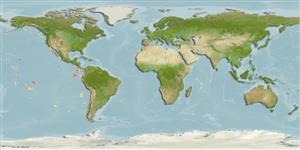Holocephali (chimaeras) (chimaeras) >
Chimaeriformes (Chimaeras) >
Chimaeridae (Shortnose chimaeras or ratfishes)
Etymology: Hydrolagus: hydro-, combining form of hydor (Gr.), water; lagos (Gr.), hare, i.e., “water rabbit,” probably referring to three pairs of tooth plates, which tend to protrude from the mouth like a rabbit’s incisors. (See ETYFish); macrophthalmus: macro-, from makros (Gr.), long; ophthalmos (Gr.), eye, referring to its large oval eyes. (See ETYFish).
Environment: milieu / climate zone / depth range / distribution range
Ekologi
laut batidemersal; kisaran kedalaman 590 - 1160 m (Ref. 97389). Subtropical
Eastern Pacific: from the central coast of Mexico, Costa Rica, Peru and Chile.
Size / Weight / umur
Maturity: Lm ? range ? - ? cm
Max length : 63.9 cm TL jantan/; (Ref. 97389); 58.1 cm TL (female)
deskripsi pendek
Morfologi | Morfometrik
This species is distinguished by the following set of characters: slender body; short and bluntly rounded snout; relatively short head (HDL 24.2-24.5% BDL); relatively large eyes (EYL 30.9-34.2% HDL); oral and preopercular lateral line canals sharing a short common branch from the infraorbital canal; relatively large pectoral fins (P1A 36.5-40.8% BDL), extending posterior to the insertion of pelvic fins; trunk's lateral line canal without sinusoidal undulations; the anterior and posterior regions of second dorsal fin considerably taller than middle region; no anal fin; tail region elongate and slender (PCA 58.3-59.9% BDL); caudal-fin axis horizontal with the fin nearly symmetrical, epaxial and hypaxial lobes equal sized; coloration uniform brown across entire body, no white markings and bluish fins (Ref. 97389).
Oviparous (Ref. 205). Eggs are encased in horny shells (Ref. 205).
Angulo, A., M.I. López, W.A. Bussing and A. Murase, 2014. Records of chimaeroid fishes (Holocephali: Chimaeriformes) from the Pacific coast of Costa Rica, with the description of a new species of Chimera (Chimaeridae) from the eastern Pacific Ocean. Zootaxa 3861(6):554-574. (Ref. 97389)
Status IUCN Red List (Ref. 130435)
ancaman kepada manusia
Harmless
penggunaan manusia
informasi lanjut
Umur / SaizPertumbuhanpanjang-beratpanjang-panjangukuran frekuensiMorfometrikMorfologiLarvaDinamika larvapemulihanKelimpahanBRUVS
AcuanBudidaya airprofil budidaya airStrainGenetikaElectrophoresesDiturunkanPenyakit-penyakitPengolahanNutrientsMass conversion
mitraGambarStamps, Coins Misc.Suara-suaraCiguateraKecepatanTipe renangArea insangOtolithsOtakPenglihatan / visi
Alat, peralatan
laporan khas
muat turun XML
Sumber internet
Estimates based on models
Phylogenetic diversity index (Ref.
82804): PD
50 = 0.5000 [Uniqueness, from 0.5 = low to 2.0 = high].
Bayesian length-weight: a=0.00282 (0.00118 - 0.00673), b=3.10 (2.89 - 3.31), in cm total length, based on LWR estimates for this (Sub)family-body shape (Ref.
93245).
Trophic level (Ref.
69278): 3.8 ±0.6 se; based on size and trophs of closest relatives
Daya lenting (Ref.
120179): Rendah, Waktu penggandaan populasi minimum 4.5 - 14 tahun (Assuming Fec <100).
Fishing Vulnerability (Ref.
59153): Moderate to high vulnerability (46 of 100).
Nutrients (Ref.
124155): Calcium = 38.6 [9.8, 112.6] mg/100g; Iron = 0.933 [0.321, 3.831] mg/100g; Protein = 16.9 [11.3, 20.1] %; Omega3 = 0.325 [0.136, 0.762] g/100g; Selenium = 40.6 [8.9, 111.7] μg/100g; VitaminA = 8.59 [2.78, 25.30] μg/100g; Zinc = 0.599 [0.309, 1.157] mg/100g (wet weight);
